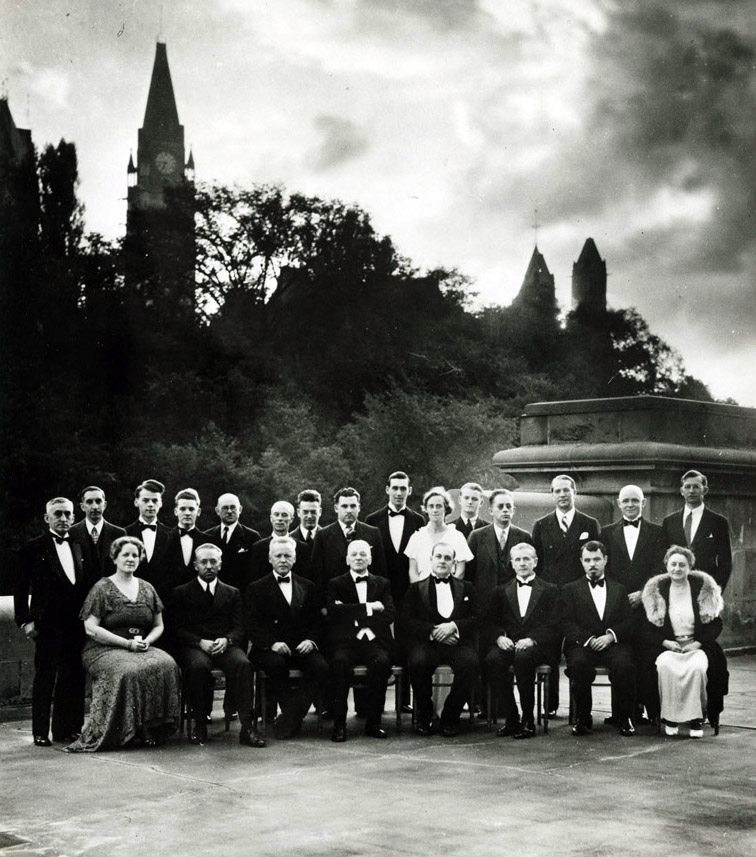Our history
Since 1936, The Guild of Carillonneurs in North America has been a leading promoter and educator of the carillon art in both North America and the world. At our organization’s founding, our charter members met to define its original "aims and objects." They wrote:
| 
Our charter members in Ottawa, Ontario, 1936 |
They would be proud to know that we did not merely meet these aims and objects, we exceeded them.
1934 | Dr. Remsen B. Ogilby (1881–1943); the president and carillonneur of Trinity College in Hartford, Connecticut; invited people interested in the carillon to attend a meeting at the college and discuss matters of common interest. About 35 people attended, and resolutions were drawn up for another meeting. This gathering became known as the First Congress of Carillonneurs in North America. |
1936 | Percival Price (1901–1985) hosted the Second Congress of Carillonneurs in North America at the Houses of Parliament in Ottawa, Ontario. At this meeting, the GCNA was established on September 3, with an executive committee and a constitution. |
1940 | We published the first volume of our journal, the Bulletin. It's the first periodical in North America dedicated to research on the carillon art and one of the few in the world today. |
1947 | Because at the time there was no existing music school for carillon outside Belgium, we established our own student examination process, the Carillonneur Exam, which encourages a higher standard of performance among our members. Today, passing the exam is a requirement for full membership. |
1961 | As early as 1940, we had been "issuing" carillon music for our members. To better encourage the growth of the available music repertoire, we established the first North American publishing house that specializes in music for the carillon. |
1962 | To exercise best practices in governance, we incorporated the GCNA under the provisions of the Minnesota Nonprofit Corporation Act. The next year, we replaced our executive committee with a board of directors and adopted bylaws. For administrative reasons, the state of incorporation was changed to California in 1992. |
1969 | We published the first issue of our semiannual newsletter. Originally titled Randschriften, which is the Dutch word for the inscriptions on a bell, it was renamed to Carillon News in 1979. |
1970 | We created the North American keyboard standards and published them in volume 21 of the Bulletin. They were revised in 1981 and are available under "Appendix D" in our Carillon Tower Design and Construction booklet. |
1978 | At the World Carillon Congress in Amersfoort, Netherlands, the World Carillon Federation was founded. We joined immediately as a member organization and have sent delegations to all of its congresses since. |
1982 | We commissioned Introduction and Sicilienne by Ronald Barnes, the first of over 25 commissions and counting. |
1988 | We hosted our first composition contest, named in honor of Johan Franco (1908–1988), a prolific composer for the carillon, among other instruments, and a respected member of the GCNA. |
1993 | To preserve our historic documents for future scholars, we began depositing them at the Anton Brees Carillon Library, located in Bok Tower Gardens, Lake Wales, Florida. A formal relationship with the library was formed in 2012. |
1996 | To better connect our members together, we went live on the internet! A major redesign of the site took place in 2007–08. In 2022, the US Library of Congress chose to include our site in its web archive of professional organizations for performing arts. |
1998 | To honor the extraordinary contributions of Ronald Barnes to the North American carillon art, we established the Ronald Barnes Memorial Grant. It enables North American residents to pursue studies in carillon performance, composition, music history, or instrument design. We first awarded grants in 2007. |
2005 | We published Carillon Tower Design and Construction, an essential resource for architects, engineers, contractors, and others contemplating the planning, design, construction, or renovation of a carillon tower. |
2011 | To meet the persistent need to recognize an intermediate skill level in carillon performance, we created the Associate Carillonneur Exam. |
2016 | We began offering grants to attend congress. Our annual congress is a great opportunity to learn about the GCNA, catch up with colleagues, discover new music, and learn new skills. In 2022, we expanded on the eligibility criteria so even more people can attend. |
2020 | We hosted our first arranging contest, named in honor of Sally Slade Warner, a renowned carillonneur and music arranger who generously donated the endowment that funds the prizes. With the onset of the pandemic and the cancellation of our congress, we began offering a webinar series, which are held regularly throughout the year and cover all topics of interest to the carillon community. |
2021 | We expanded our suite of grant programs, adding
|
2023 | We expanded the scope of the Johan Franco Composition Contest, adding a special proposal-based format for composers that are newer to the carillon or are looking for more of a collaborative process. |
Make our history yours
Contact us | Privacy Policy
Copyright © . All rights reserved.

